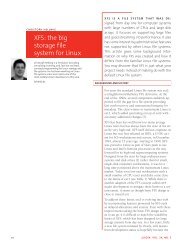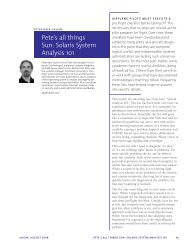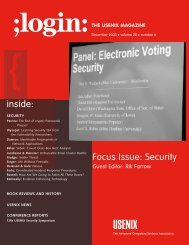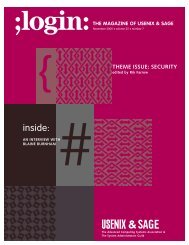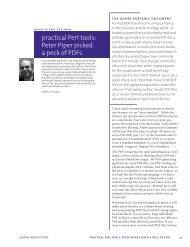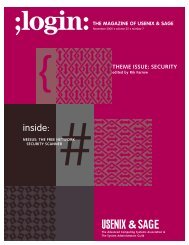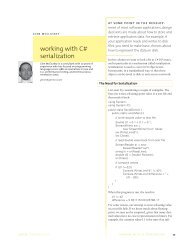You also want an ePaper? Increase the reach of your titles
YUMPU automatically turns print PDFs into web optimized ePapers that Google loves.
for public scrutiny. And to add another<br />
wrinkle, one danger of public spam/ham<br />
databases is that spammers can poison<br />
them with false data, screwing things up<br />
for everyone. That said, he encouraged<br />
users to help out with building<br />
http://spamarchive.org.<br />
BETTER BAYESIAN FILTERING<br />
Paul Graham, Arc Project<br />
Graham is the man who organized the<br />
conference and kicked off everything<br />
this week with his landmark paper from<br />
last fall, “A Plan for <strong>Spam</strong>.” Graham’s<br />
spam-filtering technique famously<br />
makes use of Bayesian statistics, a technique<br />
popular with nearly all of the<br />
speakers. The nice thing about a statistical<br />
approach, as opposed to heuristics,<br />
simple phrase matching, RBLs, etc., is<br />
that Bayesian statistics can be very<br />
robust and accurate; the down sides are<br />
that they have to be trained against a<br />
sufficiently large “corpus” of spam (most<br />
techniques have this property, though)<br />
and they have to be continually retrained<br />
over time (again, this is common).<br />
Graham was too modest to<br />
produce numbers, but subjectively his<br />
results seemed to be even better than<br />
what Yerazunis gets with MailFilter by<br />
an order of magnitude or more.<br />
Like other speakers, he predicted that<br />
spammers are going to make their messages<br />
appear more and more like “normal”<br />
mail, so we’re always going to have<br />
to be persistent about this; as one example,<br />
he showed us an email he received<br />
IN ALL CAPS from a non-Englishspeaker<br />
asking for programming help,<br />
and although it was legit, the filters<br />
insisted otherwise. “That message is the<br />
one that keeps me up at night.”<br />
Everyone interested in the spam issue<br />
should go read Graham’s paper immediately.<br />
INTERNET LEVEL SPAM DETECTION AND<br />
SPAMASSASSIN 2.50<br />
Matt Sergeant, MessageLabs<br />
<strong>Spam</strong>Assassin is a well-known Perl<br />
application for heuristically profiling<br />
messages as spam, adding headers to the<br />
message, saying, for example, “I am 72%<br />
sure this is spam because it has X Y Z,”<br />
and passing off the message to procmail,<br />
or whatever, to be handled accordingly.<br />
SA can handle a message throughput<br />
great enough that it can be deployed at<br />
the network level (whereas some of the<br />
other applications, which might have<br />
somewhat better hit rates, are still too<br />
inefficient at this point). Deployed this<br />
way, the differences in effectiveness for<br />
single vs. multiple users becomes very<br />
apparent, as 99% effective rates fall<br />
down into the 95–80% range. This happens<br />
because, again, different users<br />
define different things as spam, so mapping<br />
one fingerprint to all users can<br />
never work quite right.<br />
For an example of a tool that your company<br />
can deploy right now and get fast,<br />
decent results, SA looks like a good<br />
choice; but for the long run it looks like<br />
a Bayesian technique is going to get better<br />
performance, and SA is adding a statistical<br />
component to its toolkit. Good<br />
talk.<br />
ANTI-SPAM TECHNIQUES AT PYTHON.ORG<br />
Barry Warsaw, Pythonlabs at Zope<br />
Corporation<br />
This was another example of the “monocultures<br />
are dangerous” philosophy, as<br />
Warsaw explained how he is helping to<br />
use a variety of anti-spam techniques –<br />
from clever Exim MTA configuration to<br />
good use of <strong>Spam</strong>Assassin and procmail<br />
to fine-tuning of the Mailman mailing<br />
list engine – to work together to manage<br />
the spam problem for all things Python<br />
(Python.org, Zope, many mailing lists, a<br />
few employees, etc.).<br />
He pointed out that some very simple<br />
filters can be surprisingly effective: run a<br />
sanity check on the message’s date, look<br />
for obviously forged headers, make sure<br />
the recipients are legit, scan for missing<br />
Message-ID headers, etc. In response to<br />
the person who originally posted the<br />
article, yes, he did mention blocking<br />
outgoing SMTP as an effective element<br />
of a many-tiered spam management<br />
approach.<br />
Among other tricks for getting the different<br />
filtering tiers to play nice together,<br />
they make heavy use of the X-Warning<br />
header so that if an alarm goes off in one<br />
tier of their mail architecture, other<br />
components can respond appropriately.<br />
Cited projects included ElSpy and<br />
<strong>Spam</strong>Bayes.<br />
SPAM: THREAT OR MENACE? AN ISP'S VIEW<br />
Barry Shein, The World<br />
His core argument is that spam is “the<br />
rise of organized crime on the Internet,”<br />
that filters are nice but that the mail<br />
architecture itself is fundamentally<br />
flawed, and that ISPs like his – in 1989,<br />
The World was the world’s first dialup<br />
ISP – are being killed by the problem.<br />
Shein was very annoyed that all these<br />
talented people are having to clean up a<br />
mess like this when they should be out<br />
working on more interesting stuff. His<br />
big hope seemed to be that legislation<br />
will someday come to the rescue, but he<br />
sounded very pessimistic. (Others in the<br />
room seemed to feel that this was a very<br />
interesting machine-learning problem<br />
and weren’t really fazed by his pessimism<br />
– but, then, most of the people<br />
in the room don’t run ISPs.)<br />
He also suggested that we need to find a<br />
way to make spammers pay for the<br />
bandwidth they are consuming (rather<br />
than having users and ISPs shoulder the<br />
burden) but didn’t seem to know how<br />
we might go about implementing this.<br />
At all.<br />
SMARTLOOK: AN E-MAIL CLASSIFIER<br />
ASSISTANT FOR OUTLOOK<br />
Jean-David Ruvini, e-lab Bouygues SA<br />
This was an interesting product. Ruvini’s<br />
company is developing an extension to<br />
66 Vol. 28, No. 3 ;login:



